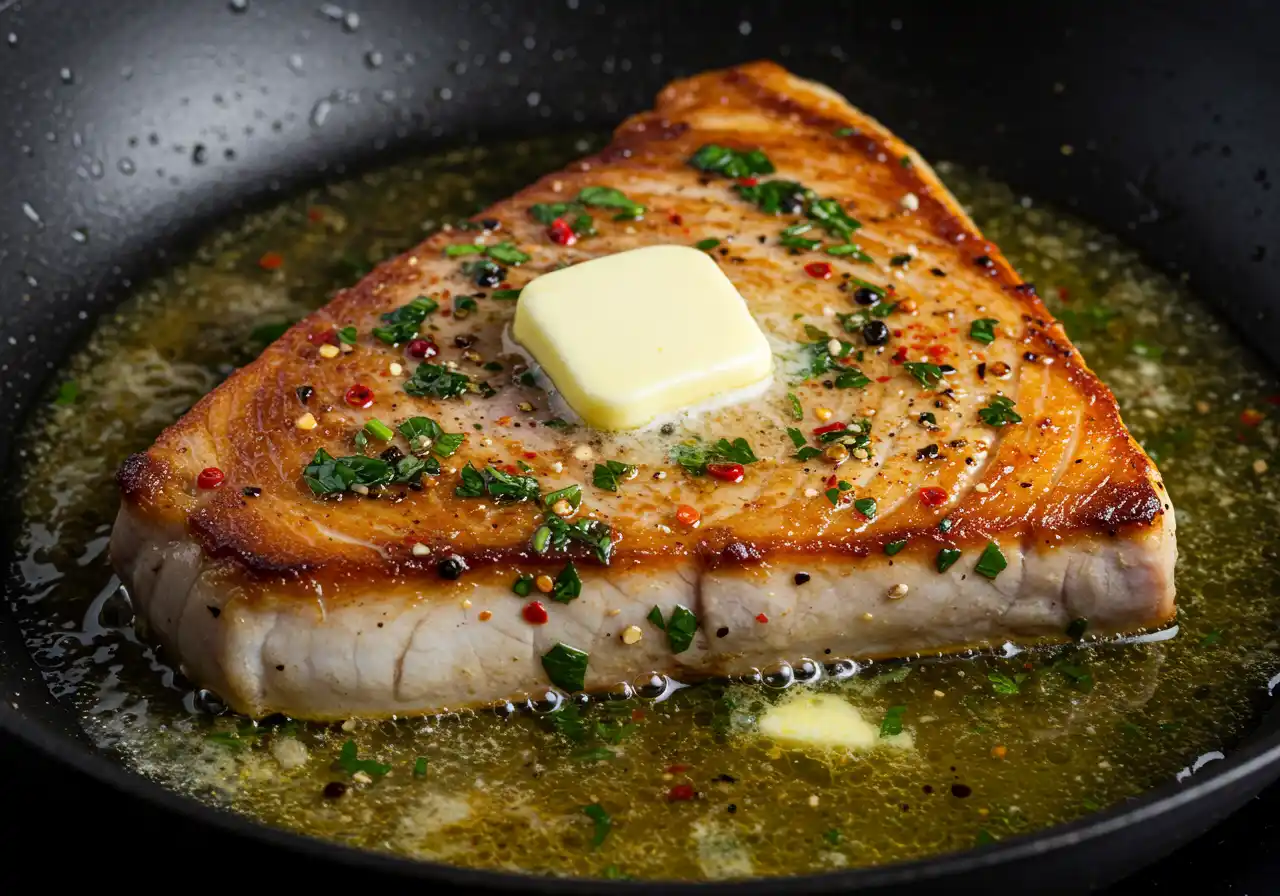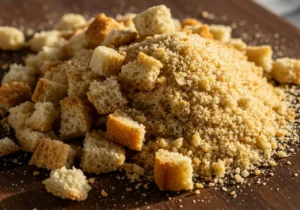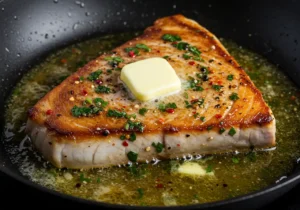Introduction :
Swordfish steak is one of the most flavorful and satisfying seafood dishes you can make at home. If you are searching for a great Swordfish Steak Recipe, look no further. Unlike delicate white fish, swordfish has a firm, meaty texture, making it an excellent alternative to traditional steaks. Whether you try a Grilled Swordfish recipe for a smoky, charred flavor or a Baked Swordfish recipe for a tender, juicy bite, this high-protein, low-carb meal is a fantastic choice for seafood lovers and healthy eaters alike.
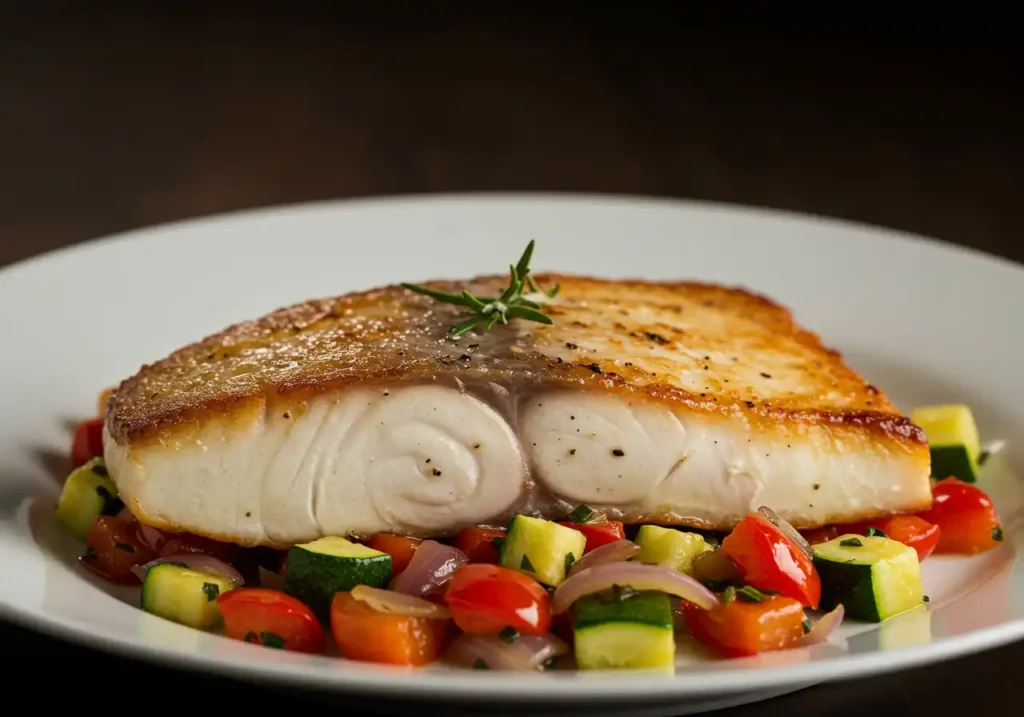
One of the biggest challenges when cooking swordfish is getting the texture just right. If cooked improperly, it can turn out dry and tough, but when done correctly, it’s moist, tender, and packed with flavor. The key is to use the right cooking method, proper seasoning, and correct cooking times to bring out the natural richness of the fish. Whether you choose a Grilled Swordfish steak recipe for a smoky, charred taste or a Baked Swordfish steak recipe for a juicy, oven-cooked option, mastering these techniques will ensure a delicious and satisfying meal.
In this guide, we’ll walk you through how to cook swordfish steak perfectly every time, covering everything from choosing the best cuts, marinating techniques, different cooking methods, and expert tips. Whether you’re grilling, pan-searing, or baking your swordfish, you’ll learn all the essential techniques to make it taste like a restaurant-quality dish at home.
A Firm, Meaty Fish Perfect for Steaks
Swordfish is a unique type of seafood because of its firm, dense texture, which sets it apart from flaky fish like cod or tilapia. This steak-like consistency makes it perfect for grilling, pan-searing, or broiling without falling apart. Many people who are new to seafood or prefer heartier textures enjoy swordfish because it closely resembles a juicy cut of meat rather than a delicate fish fillet.
Why Swordfish is Great for Steaks
- Thick and Dense Texture: Unlike other fish, swordfish holds its shape well, making it easy to cook without worrying about it breaking apart.
- Rich, Buttery Flavor: It has a mild yet slightly sweet taste, which pairs well with bold marinades, spices, and sauces.
- Versatile Cooking Methods: You can prepare swordfish in multiple ways, including grilling, pan-searing, baking, and even air-frying.
- Great Meat Alternative: Because of its hearty bite, swordfish is a great option for those looking to eat less red meat but still crave a satisfying, steak-like meal.
What to Look for When Buying Swordfish Steaks
- Color: Fresh swordfish should have a light pink to white color. Avoid any pieces that look dull or brownish.
- Texture: It should feel firm to the touch, not mushy or slimy.
- Smell: Fresh swordfish should have a mild ocean scent, not a strong fishy odor.
- Cut Thickness: Aim for steaks that are at least 1 to 1.5 inches thick so they cook evenly.
By understanding what makes swordfish a premium seafood option, you’ll be able to choose the best-quality fish and cook it to perfection!
What Makes Swordfish Steak Recipe Special?
Swordfish steak is not your typical seafood option—it’s a unique, flavorful, and satisfying choice that stands out among other fish varieties. Unlike delicate, flaky fish, swordfish has a firm, meaty texture, making it an excellent substitute for traditional meat-based steaks. Whether grilled, pan-seared, or baked, swordfish retains its shape and soaks up flavors beautifully, making it a favorite among seafood lovers and even those who aren’t typically fans of fish.
In this section, we’ll dive into what makes swordfish steak special, from its texture and taste to its nutritional benefits and how to choose the best cut for cooking.
A Firm, Meaty Fish Perfect for Steaks
Swordfish is known for its thick, steak-like texture, which makes it different from flaky fish like cod, tilapia, or salmon. It has a dense, juicy bite, making it a favorite among those who prefer heartier seafood dishes.
Why Swordfish is Great for Steaks
- Firm and Dense Texture – Unlike delicate fish that can fall apart during cooking, swordfish retains its shape well, making it perfect for grilling, pan-searing, and broiling.
- Rich and Mild Flavor – Swordfish has a slightly sweet, buttery taste, which makes it ideal for pairing with bold marinades, citrus flavors, and rich sauces.
- Perfect Alternative to Meat – Because of its hearty bite, swordfish is an excellent choice for those looking to eat less red meat while still enjoying a satisfying, protein-rich meal.
- Versatile Cooking Methods – Whether you want to grill it over an open flame, sear it in a cast-iron skillet, or bake it with herbs and lemon, swordfish adapts well to different cooking styles.
Pro Tip for Cooking Swordfish Steaks
Since swordfish has a low oil content, it can dry out if overcooked. The best way to retain its moist and tender texture is to cook it until it reaches an internal temperature of 130°F and let it rest for a few minutes before serving.
Nutritional Benefits of Swordfish
Swordfish isn’t just delicious—it’s also packed with nutrients that make it a healthy choice for your diet. Whether you’re looking for a high-protein meal, a low-carb seafood option, or a dish rich in omega-3 fatty acids, swordfish is a powerhouse of nutrition.
Health Benefits of Eating Swordfish
✅ High in Protein – A single serving of swordfish (about 3.5 ounces) contains 20+ grams of protein, making it a great choice for those looking to build muscle or stay full longer.
✅ Rich in Omega-3 Fatty Acids – Omega-3s are essential for heart health, brain function, and reducing inflammation. Swordfish provides a good amount of these healthy fats, making it a great option for overall well-being.
✅ Low in Carbs and Calories – Swordfish is naturally low in carbohydrates and has a moderate calorie count, making it ideal for those on low-carb, keto, or paleo diets.
✅ Packed with Vitamins and Minerals – Swordfish is a great source of:
- Vitamin B12 (supports brain health and energy levels)
- Selenium (boosts immune function and acts as an antioxidant)
- Potassium (important for muscle function and heart health)
Is Swordfish Safe to Eat?
While swordfish is highly nutritious, it’s important to note that it is a larger predatory fish, meaning it can contain higher levels of mercury. For this reason, it’s best to consume swordfish in moderation—around one serving per week is considered safe for most adults. Pregnant women and young children should limit their intake to avoid excessive mercury exposure.
How to Choose the Best Swordfish Steak
To get the best flavor and texture from your swordfish steak, you need to start with high-quality fish. Whether you’re buying fresh or frozen, here’s how to choose the best swordfish steak for your recipe.
Fresh vs. Frozen Swordfish: Which is Better?
- Fresh Swordfish:
- Best if purchased from a trusted fish market or seafood counter.
- Should have a mild, ocean-like scent (not a strong fishy smell).
- Look for firm, moist flesh that bounces back when pressed.
- Frozen Swordfish:
- A great option if you’re not near a seafood market.
- Make sure it’s vacuum-sealed and labeled as wild-caught if possible.
- Avoid packages with ice crystals, as this may indicate freezer burn.
What to Look for in a Fresh Swordfish Steak
Color:
- Fresh swordfish should have a light pink to white color with a slight translucency.
- Avoid steaks that look brownish or dull, as this may indicate old or poor-quality fish.
Texture:
- The steak should feel firm and dense, not mushy or soft.
- Press it gently with your finger—it should spring back instead of leaving an indentation.
Smell:
- Fresh swordfish should have a mild, clean, ocean scent.
- If it smells overly fishy or sour, it’s likely past its prime.
Cut Thickness:
- Choose steaks that are at least 1 to 1.5 inches thick.
- Thin steaks can dry out quickly, while thicker steaks retain more moisture and flavor.
Wild-Caught vs. Farmed Swordfish
- Wild-Caught Swordfish:
- Generally considered the better option in terms of taste and sustainability.
- Often has a firmer texture and richer flavor.
- Farmed Swordfish:
- May contain higher fat content but can still be a good option.
- Always check for responsibly sourced certifications if buying farmed fish.
Final Thoughts on What Makes Swordfish Special
Swordfish Steak recipe is a fantastic seafood choice for those looking for a hearty, flavorful, and nutritious meal. With its firm texture, mild sweetness, and versatility, it’s an excellent alternative to traditional steaks and can be cooked in a variety of ways.
By choosing high-quality swordfish, understanding its nutritional benefits, and using the right cooking techniques, you’ll be able to prepare a delicious and restaurant-worthy swordfish steak at home—every single time!
Essential Ingredients for a Perfect Swordfish Steak Recipe
To create the perfect swordfish steak recipe, you need more than just high-quality fish. The right ingredients, seasonings, and tools will elevate your dish and enhance the flavor of the swordfish. Whether you’re preparing a simple grilled steak or looking for a more complex marinade, understanding what goes into making the perfect swordfish dish is key.
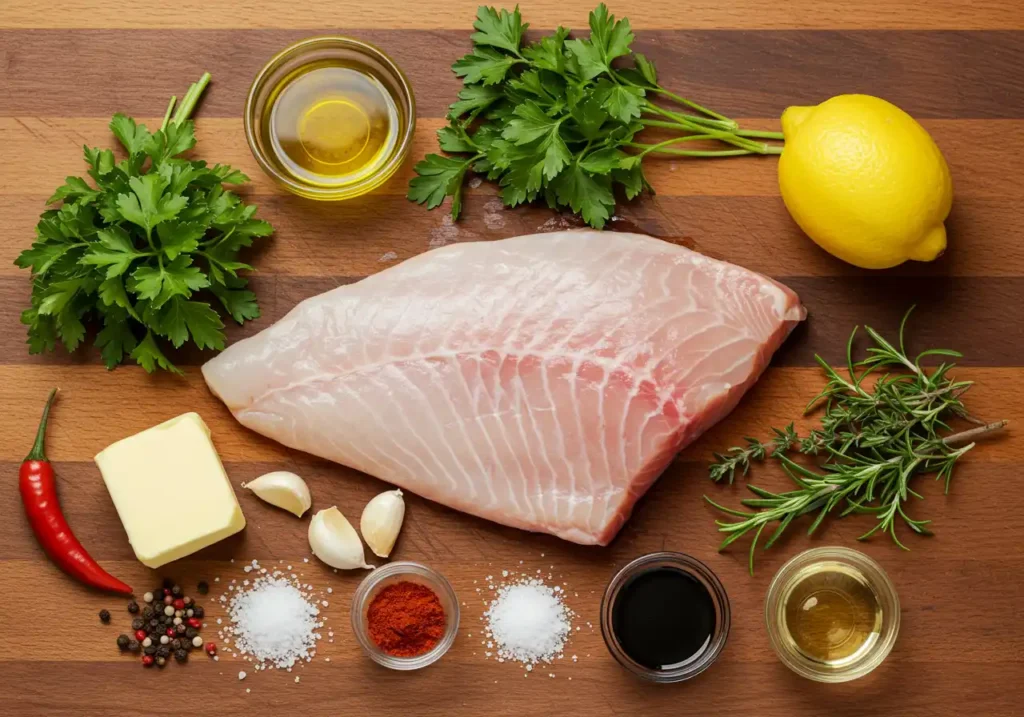
In this section, we’ll guide you through the must-have ingredients, the best marinades and seasonings, and the essential cooking tools you’ll need to create a swordfish steak that’s bursting with flavor and cooked to perfection.
Must-Have Ingredients
The foundation of a perfect swordfish steak begins with selecting the best ingredients. While the swordfish fillet itself is the star of the dish, the right seasonings, fats, and herbs can take your recipe to the next level. Here’s what you need:
Swordfish Fillet
- Freshness is key when it comes to swordfish. Whether you opt for fresh or frozen, make sure the fillets are firm, moist, and free of any off smells.
- For a meaty, juicy texture, go for steaks at least 1-1.5 inches thick. Thin fillets cook too quickly and risk drying out.
Olive Oil
- Olive oil is a staple for many cooking methods, providing healthy fats and enhancing the flavor of the fish. Use it to coat the swordfish before grilling or pan-searing.
- If you want to add a touch of flavor, use extra virgin olive oil for a richer, more robust taste.
Garlic
- Fresh garlic adds savory depth and aromatic qualities to swordfish steak. Whether you choose to mince or crush the garlic, it brings out the best in the fish when sautéed in oil or butter.
- Garlic butter is a popular choice for a rich, flavorful sauce to drizzle over the steak.
Lemon
- The zest and juice of fresh lemon adds a bright, citrusy tang that complements the richness of swordfish.
- A quick squeeze of lemon juice over the cooked steak balances the flavors and enhances the fish’s natural sweetness.
Butter
- Butter provides a rich, silky finish when pan-searing or basting swordfish. For extra flavor, use unsalted butter to prevent over-salting and to highlight the fish’s natural taste.
- Brown butter can add a nutty depth to the dish when combined with garlic or lemon.
Herbs
- Fresh herbs like thyme recipes, rosemary, or parsley pair beautifully with swordfish, imparting a subtle yet aromatic flavor.
- When grilling or pan-searing, herb sprigs can be added to the pan or grill for a fragrant infusion.
Black Pepper
- Freshly ground black pepper is essential for seasoning swordfish. Its mild heat and earthy aroma bring out the flavors of the fish without overwhelming it.
- Add it to the fish before cooking and finish with a sprinkle after it’s cooked for a bit of extra seasoning.
Best Marinades and Seasonings
Marinades and seasonings are key to infusing swordfish steak with extra flavor. Whether you prefer a bold, savory marinade or a light citrus dressing, the right seasonings can enhance the natural richness and juiciness of the fish. Here are a few top picks:
Garlic Butter Marinade
- A garlic butter marinade is an easy way to boost the flavor of swordfish. Combine melted butter, minced garlic, lemon juice, and herbs like thyme or rosemary. Marinate the swordfish for 20–30 minutes before cooking for a rich, buttery taste.
- This marinade not only moisturizes the fish but also adds depth and a fragrant finish when drizzled over the cooked steak.
Lemon Herb Marinade
- A lemon herb marinade is perfect for those who want to enhance the fresh, citrusy notes of swordfish. Combine lemon juice, olive oil, garlic, parsley, and a touch of salt and pepper.
- The acid from the lemon helps tenderize the fish, while the herbs bring out its natural flavors. Marinate for 15–20 minutes to allow the swordfish to absorb the bright, fresh flavors.
Mediterranean Flavors
- Mediterranean-style marinades are fantastic for adding bold, savory flavors to swordfish. Mix together olive oil, garlic, lemon juice, oregano, and a pinch of chili flakes for a zesty kick.
- This type of marinade pairs wonderfully with grilled swordfish, as the herbs and spices give the fish a smoky, aromatic finish.
Spicy Cajun or Blackened Seasoning
- For those who enjoy a bit of heat, a Cajun or blackened seasoning adds a spicy kick to swordfish. Combine paprika, cayenne pepper, garlic powder, onion powder, thyme, and oregano for a flavorful rub.
- Apply the seasoning liberally to the fish, then cook it on high heat to achieve a crispy, flavorful crust.
Tools You Need for Cooking Swordfish Steak
The right cooking tools can make all the difference when preparing swordfish steak. Whether you’re grilling, pan-searing, or broiling, having the right equipment will ensure your swordfish is cooked evenly and retains its moisture.
Cast-Iron Skillet
- A cast-iron skillet is perfect for pan-searing swordfish steaks, as it provides even heat distribution and a crispy, golden crust.
- The heavy-duty nature of the skillet allows you to sear the fish at high heat without the risk of sticking. It also helps retain heat for consistent cooking.
Grill
- A grill is ideal for cooking swordfish steaks, especially if you want a smoky, charred flavor. Preheat your grill to medium-high heat and oil the grates to prevent the fish from sticking.
- Use a grill basket or fish grill tray if you want to ensure that your swordfish stays intact and doesn’t fall through the grill grates.
Tongs
- Tongs are a must-have tool for handling delicate swordfish steaks. Use them to easily flip the fish while grilling or pan-searing without damaging its flesh.
- Tongs allow for better control over your fish and help you avoid overcooking by ensuring an even, gentle flip.
Fish Spatula
- A fish spatula is an essential tool for turning swordfish steaks, especially when they’re cooked in a skillet or on a grill. The thin, flexible design makes it easy to slide under the fish, lifting it without breaking it apart.
- If you’re cooking swordfish on the grill, a fish spatula can help you gently flip the steaks without disturbing the texture or moisture.
Final Thoughts on Essential Ingredients and Tools for Swordfish Steak Recipe
With the right ingredients, flavorful marinades, and proper tools, you can achieve a perfect swordfish steak that’s juicy, flavorful, and cooked to perfection every time. Whether you choose a classic garlic butter marinade or opt for Mediterranean-style seasonings, the right combination of ingredients will make all the difference. And with the best cooking tools like a cast-iron skillet or grill, you’ll have the perfect platform for a delicious swordfish dish.
Step-by-Step Guide to Cooking Swordfish Steak
Cooking a swordfish steak can be simple and straightforward if you follow the right steps. Swordfish is a meaty, firm fish, making it ideal for a variety of cooking methods, from grilling to pan-searing to baking. In this section, we’ll walk you through each step, from preparing the fish to choosing the best cooking method, and teach you how to tell when your swordfish is perfectly cooked.
Whether you’re a first-time cook or a seasoned pro, this guide will ensure that your swordfish steak is flavorful, tender, and cooked to perfection every time.
Preparing the Swordfish (Thawing, Seasoning, Marinating)
Before you get started with cooking, it’s important to prepare your swordfish properly. This includes ensuring it’s thawed (if frozen), seasoned, and potentially marinated to maximize flavor. Here’s how:

Thawing Frozen Swordfish
- If you’re using frozen swordfish, it’s important to thaw it properly before cooking. The best way to thaw frozen swordfish is to place it in the refrigerator overnight. This ensures it thaws slowly and stays at a safe temperature.
- For a quick thaw, you can place the fish in a sealed plastic bag and submerge it in cold water for 30–60 minutes, making sure to change the water every 30 minutes. Avoid thawing swordfish at room temperature, as this can lead to bacteria growth.
Seasoning Swordfish
- Seasoning is crucial to bringing out the best flavors of the swordfish. Start by patting the swordfish fillet dry with a paper towel to remove any excess moisture.
- Rub the fish with olive oil to help the seasoning stick. Then, sprinkle with salt, freshly ground black pepper, and other flavor-enhancing seasonings such as garlic powder, paprika, or lemon zest.
- If you prefer a more intense flavor, you can apply a dry rub or use your favorite Cajun or Mediterranean spices.
Marinating Swordfish
- Marinating swordfish isn’t necessary, but it can infuse extra flavor and moisture into the fish. Consider marinating swordfish for 15–30 minutes (no longer than an hour) in a combination of olive oil, lemon juice, garlic, and herbs.
- For an additional flavor boost, you can try a garlic butter marinade or a spicy Cajun marinade for a bold, zesty kick.
Cooking Methods – Grilled, Pan-Seared, and Baked Swordfish Steak Recipe
There are several popular methods for cooking swordfish steaks, and each brings out different qualities in the fish. Whether you prefer the smoky flavor from grilling, the crispy exterior from pan-searing, or the tender texture from baking, we’ll cover the best techniques for cooking swordfish to perfection.
Grilled Swordfish
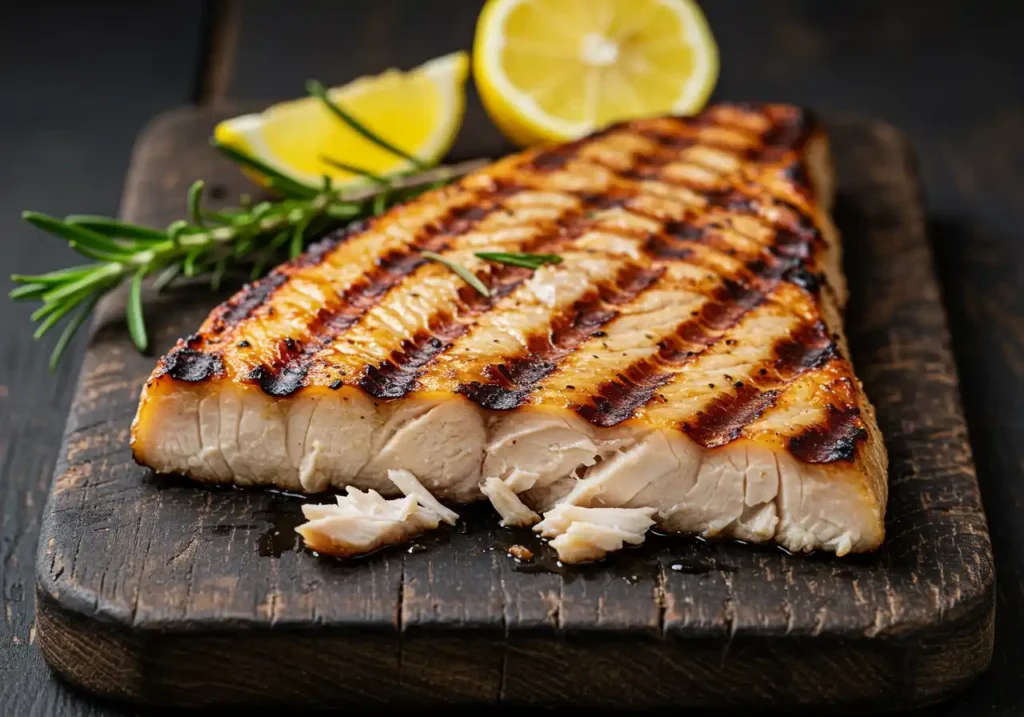
- Grilling swordfish gives it a delicious smoky flavor and a slightly charred crust. Preheat your grill to medium-high heat and oil the grates to prevent sticking.
- Place the swordfish steaks on the grill and cook for 4–5 minutes per side, depending on the thickness of the fillets. Use tongs or a fish spatula to flip the fish gently, so it doesn’t fall apart.
- For a nice touch, grill lemon halves alongside the fish, and squeeze the lemon juice over the cooked swordfish for a zesty finish.
Pan-Seared Swordfish
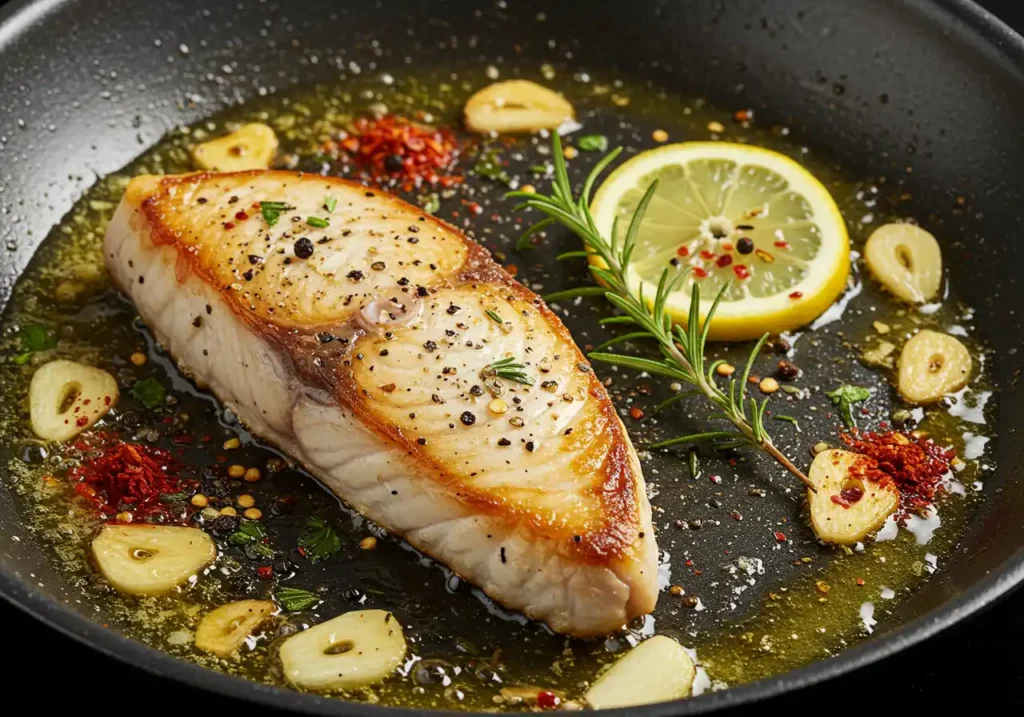
- For a crispy, golden crust, pan-searing is a great option. Start by heating a cast-iron skillet over medium-high heat and adding olive oil or butter.
- Once the pan is hot, place the swordfish steaks in the skillet and cook for 3–4 minutes per side. You can baste the fish with the pan’s juices (butter, garlic, herbs) to enhance the flavor.
- Pan-searing gives you the opportunity to cook the fish in garlic butter, adding a rich, savory flavor to the fish. Once the fish has a golden crust, reduce the heat to cook through without burning.
Baked Swordfish
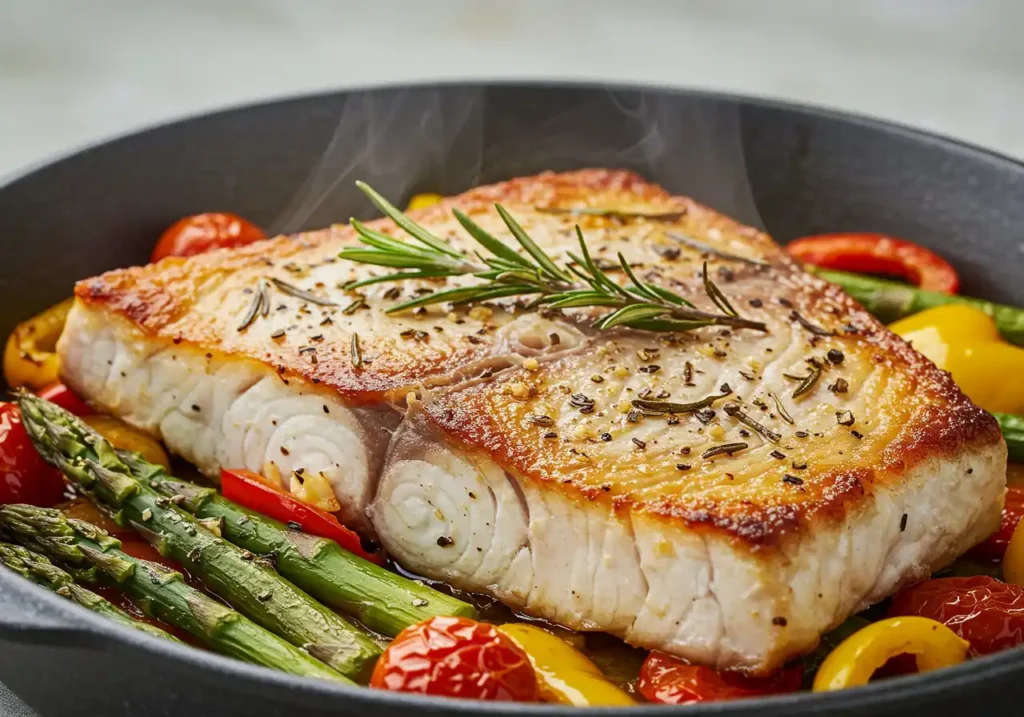
- Baking swordfish is an ideal method if you prefer a hands-off approach. Preheat your oven to 375°F (190°C) and line a baking sheet with parchment paper or lightly grease it with oil.
- Place the swordfish steaks on the sheet and drizzle with olive oil, sprinkle with herbs, and season with salt and pepper.
- Bake for 10–15 minutes, depending on the thickness of the fish. Baking is great if you want to retain moisture in the fish while still achieving a mild, flaky texture.
How to Tell When Swordfish is Done Cooking (Temperature & Texture)
One of the key aspects of cooking swordfish perfectly is knowing when it’s done. Overcooking swordfish can lead to dry, tough fish, so it’s essential to pay attention to both temperature and texture during the cooking process.
Using a Meat Thermometer
- For the most accurate reading, use a meat thermometer to check the internal temperature of the swordfish. Swordfish is done when the internal temperature reaches 145°F (63°C).
- Once it hits this temperature, remove the swordfish from the heat and let it rest for a couple of minutes. The residual heat will finish cooking the fish.
Checking the Texture
- The texture of cooked swordfish should be firm and opaque. You can check by gently pressing the fish with a fork. If it flakes easily but still holds together, it’s cooked perfectly.
- The edges of the swordfish should have a slight crust, while the inside remains moist and tender. If the fish is still translucent, it needs more cooking time.
Avoiding Overcooking
- Swordfish can become dry if overcooked, so always keep a close eye on it as it cooks. If you’re using the grill or skillet, it’s best to monitor the cooking time closely and flip the fish only once.
- If you’re baking swordfish, it’s important to check the fish at the 10-minute mark to prevent overcooking.
Final Thoughts on Cooking Swordfish Steak
By following this step-by-step guide, you can easily achieve a delicious swordfish steak every time. Whether you decide to grill, pan-sear, or bake your swordfish, the key to success lies in proper preparation, choosing the right cooking method, and knowing when the fish is perfectly cooked. Keep an eye on the texture and temperature, and you’ll have a steak that’s moist, flavorful, and full of rich, meaty goodness.
Pro Tips to Get Swordfish Steak Perfect Every Time
Cooking swordfish steak may seem straightforward, but there are a few essential tips that can take your dish from good to great. Whether you’re following a Grilled Swordfish steak recipe for a smoky, charred flavor or a Baked Swordfish steak recipe for a tender, juicy bite, these expert insights will ensure your swordfish steak turns out moist, tender, and full of flavor. Let’s dive into the pro tips for avoiding common mistakes, mastering cooking temperatures, and perfecting your swordfish steak pairing.
Avoiding Dry, Overcooked Swordfish (LSI: moist and tender swordfish)
One of the most common mistakes when cooking swordfish is overcooking, which leads to dry, tough fish. Swordfish is a meaty fish with a firm texture, but it can easily become dry if left on the heat for too long. Here’s how to keep your swordfish moist and tender:
Don’t Overcook Swordfish
- Swordfish can become tough and rubbery when overcooked, so it’s important to avoid cooking it too long. Always monitor the cooking process carefully to ensure you’re hitting the sweet spot for texture and flavor.
- Swordfish steaks are best cooked to medium-rare to medium, with an internal temperature of around 130°F to 140°F (54°C – 60°C). This will give you a juicy, tender steak without compromising on flavor.
- Remove from heat slightly early and let the fish rest for a few minutes before serving. The residual heat will continue to cook the swordfish, ensuring that it’s perfectly cooked on the inside.
Use a Thermometer
- A meat thermometer is your best friend when it comes to ensuring your swordfish is cooked perfectly. Insert the thermometer into the thickest part of the steak to check the temperature. This method eliminates any guesswork, so you can avoid both undercooking and overcooking.
- Keep in mind that swordfish should not feel mushy when pressed. It should have a firm, flakey texture when properly cooked.
The Best Cooking Temperatures & Timing (Entities: medium-rare, 130°F internal temp)
Understanding the right cooking temperatures and timing is key to getting a swordfish steak perfectly cooked every time. Whether you’re grilling, pan-searing, or baking, each method has its optimal temperature range and timing that leads to the best results.
Grilling Swordfish Steak
- Preheat your grill to medium-high heat, ideally between 375°F and 400°F (190°C – 200°C).
- Grill the swordfish steaks for about 4–5 minutes per side, depending on the thickness. Flip the steaks only once, and use tongs or a fish spatula to handle them gently.
- For medium-rare, remove the steak from the grill when it reaches an internal temperature of 130°F (54°C). For medium, remove it at 140°F (60°C). Let the fish rest for a few minutes after grilling to let the juices redistribute.
Pan-Searing Swordfish Steak
- Heat a cast-iron skillet over medium-high heat and add olive oil or butter.
- Cook the swordfish steaks for 3–4 minutes per side, or until they form a golden crust on the outside. Flip them only once during cooking to keep them intact.
- Similar to grilling, aim for an internal temperature of 130°F for medium-rare and 140°F for medium.
- As an extra pro tip, baste the steaks with butter and garlic during the last minute of cooking for added flavor.
Baking Swordfish Steak
- Preheat your oven to 375°F (190°C) and place the swordfish steaks on a baking sheet lined with parchment paper.
- Bake the fish for 10–15 minutes, checking the internal temperature at the thickest part. Bake until it reaches 130°F for medium-rare or 140°F for medium.
- Keep in mind that oven times can vary based on the thickness of the steaks, so start checking after 10 minutes to avoid overcooking.
What to Serve with Swordfish Steak? (Entities: roasted vegetables, rice, salad, sauces)
Swordfish steak recipes are deliciously versatile and pairs well with a variety of sides and sauces. Whether you’re looking for light, refreshing sides or something more hearty, here are some great options to complement the rich, meaty flavor of swordfish.
Roasted Vegetables
- Roasted vegetables like asparagus, zucchini, brussels sprouts, or carrots make an excellent choice as side dishes for swordfish. The natural sweetness of roasted veggies perfectly balances the rich, savory flavor of the fish.
- For extra flavor, toss the vegetables in olive oil, garlic, lemon zest, and fresh herbs like thyme or rosemary before roasting.
Rice or Grains
- A light, fluffy rice or a grain like quinoa or couscous is a great way to absorb the juices and sauces from the swordfish. For a more flavorful option, consider making lemon rice or herbed couscous to enhance the fresh, zesty flavors of the fish.
- Wild rice adds a nutty, earthy element that pairs beautifully with swordfish, while brown rice gives you a heartier, satisfying option.
Salads
- Fresh salads provide a crisp, light contrast to the rich fish. Try a mixed greens salad with citrus dressing or a Greek salad with tomatoes, cucumbers, and olives for a Mediterranean vibe.
- A roasted beet salad with goat cheese and arugula also works wonderfully, offering a touch of sweetness and earthiness to balance the flavors.
Sauces and Toppings
- The right sauce can elevate the flavor of your swordfish. Consider a garlic butter sauce, lemon herb sauce, or tahini dressing.
- For a Mediterranean touch, try a tzatziki sauce made with yogurt, cucumber, and fresh dill. If you prefer a spicy kick, a chipotle mayo or sriracha aioli will pair well with the rich texture of swordfish.
- Chimichurri, a tangy sauce made with parsley, garlic, and vinegar, can add a burst of fresh flavor that contrasts beautifully with the grilled fish.
Final Tips for Swordfish Perfection
By following these pro tips, you’ll be able to make swordfish steak perfectly tender, moist, and delicious every time. Avoid overcooking the fish, stick to the recommended internal temperatures, and pair it with fresh sides and flavorful sauces to create a well-rounded meal. Whether you’re cooking for a special occasion or just a regular dinner, these expert tips will help you serve a meal that impresses.
Frequently Asked Questions About Cooking Swordfish
Cooking swordfish may raise some common questions for home cooks. Whether you’re a beginner or an experienced chef, understanding how to get the best results, and knowing the health benefits or storage tips, can make your swordfish cooking experience much smoother. Here, we answer some of the most frequently asked questions about preparing and cooking swordfish to help you make the most of this delicious fish.
Is Swordfish Healthy?
Swordfish is not only delicious but also packs a variety of nutritional benefits that can make it a valuable part of a balanced diet. Let’s break down why swordfish can be considered a healthy choice for your meals:
High in Protein
- Swordfish is a high-protein fish that provides an excellent source of lean protein. A 3-ounce serving of cooked swordfish contains about 20 grams of protein, making it an ideal choice for anyone looking to meet their protein needs.
Rich in Omega-3 Fatty Acids
- Swordfish is a great source of omega-3 fatty acids, which are essential for heart health. Omega-3s have been shown to reduce inflammation, lower blood pressure, and help prevent heart disease. A serving of swordfish offers a good amount of these heart-healthy fats.
Low in Carbohydrates
- Swordfish is a low-carb food, which can make it an excellent option for those following a low-carb or ketogenic diet. It contains minimal carbohydrates, which helps keep the focus on high-quality proteins and healthy fats.
Important Considerations
- Mercury Levels: Swordfish can contain higher levels of mercury compared to other fish, so it’s important to consume it in moderation, especially for pregnant women, children, and those with health concerns related to mercury exposure. Consider limiting swordfish consumption to 2-3 times per week.
Overall, swordfish is a nutritious, high-protein choice with several health benefits when consumed as part of a balanced diet.
Can I Cook Swordfish Without a Grill?
While grilling is a popular method for cooking swordfish, you don’t have to own a grill to enjoy this delicious fish. Swordfish can be cooked using a variety of methods that deliver great results, so don’t worry if you don’t have access to an outdoor grill. Here are some alternative methods to try:
Pan-Seared Swordfish
- Pan-searing swordfish in a cast-iron skillet is one of the best alternatives to grilling. You can get a beautiful golden crust on the outside while keeping the interior moist and flaky. Use olive oil or butter and cook the fish on medium-high heat for 3-4 minutes per side, depending on the thickness of the steak. You can even add a garlic butter sauce at the end for extra flavor.
Oven-Baked Swordfish
- Baking swordfish in the oven is a great option for an easy, hands-off approach. Preheat your oven to 375°F (190°C) and bake the swordfish for about 10-15 minutes or until it reaches the desired internal temperature. This method allows the fish to cook evenly while retaining moisture. You can also bake it in a lemon-butter sauce for added flavor.
Broiled Swordfish
- Broiling is another excellent cooking method for swordfish. Just like grilling, broiling exposes the fish to direct heat, which gives it a charred, smoky flavor. Simply preheat your broiler, place the swordfish steaks on a baking sheet, and broil for about 4-5 minutes per side, watching closely to avoid burning.
With these methods, you can enjoy delicious swordfish steak recipe even if you don’t have access to a grill. Feel free to experiment with these alternatives to find your favorite cooking style!
How Do I Store and Reheat Leftover Swordfish?
Sometimes, you may have leftover swordfish after cooking, and knowing how to properly store and reheat it will ensure it stays fresh and delicious. Here are some storage tips and reheating methods to help preserve your leftover swordfish:
Storing Leftover Swordfish
- Cool Down Quickly: To avoid any food safety issues, always let your swordfish cool down to room temperature before storing it. Try to refrigerate leftovers within 2 hours of cooking.
- Use an Airtight Container: Store the swordfish in an airtight container to prevent it from absorbing any unwanted odors from the fridge. For best results, wrap it tightly in plastic wrap or foil before placing it in the container.
- Refrigerate or Freeze: Leftover swordfish should be stored in the refrigerator for up to 2 days. If you need to store it for a longer period, you can freeze it for up to 3 months. Be sure to wrap it well in freezer-safe packaging before freezing.
Reheating Swordfish
- Avoid Overcooking: When reheating swordfish, you want to be careful not to dry it out by overcooking it again. Here are some gentle methods to reheat without losing moisture:
- Oven Method: Preheat your oven to 350°F (175°C), place the swordfish on a baking sheet, and cover it with foil. Reheat for about 10-12 minutes, checking periodically to avoid overcooking. You can also drizzle a bit of butter or olive oil over the fish to help retain moisture.
- Microwave Method: For quick reheating, use the microwave. Place the swordfish on a microwave-safe plate and cover it with a damp paper towel. Microwave in 30-second intervals on low heat to ensure the fish doesn’t dry out.
- Stovetop Method: If you prefer, you can also pan-sear the leftover swordfish in a skillet over low heat with a little butter or oil to keep it moist. Just heat it for 1-2 minutes per side.
By following these storage and reheating tips, you’ll be able to enjoy leftover swordfish without sacrificing its quality and taste.
Conclusion
Cooking swordfish steak is an art that, once mastered, can provide you with a delicious and satisfying meal every time. Whether you prefer a Grilled Swordfish steak recipe for a smoky, charred taste or a Baked Swordfish steak recipe for a tender, juicy texture, the right techniques make all the difference. By following the step-by-step guide, understanding the essential ingredients, and applying pro tips, you’ll be able to cook a swordfish steak that is moist, tender, and packed with flavor. Here’s a quick recap of the key points:
Key Takeaways for Perfect Swordfish Steak:
- Choosing the Right Swordfish: Always opt for fresh swordfish fillets (or well-thawed frozen swordfish) with a bright pink color and firm texture. This will ensure your steak is both flavorful and properly cooked.
- Essential Ingredients: Whether you choose a simple garlic butter or a lemon herb marinade, the right blend of seasonings and a touch of olive oil or butter will elevate your swordfish to new heights.
- Cooking Techniques: Mastering the pan-sear, grill, or bake methods will give you the flexibility to cook swordfish steak however you prefer, achieving a perfectly seared, juicy fish.
- Pro Tips: Avoid overcooking your swordfish by watching the internal temperature and aiming for a medium-rare finish of around 130°F. And don’t forget the side dishes—roasted vegetables, rice, or a fresh salad will perfectly complement your meal.
Encouragement to Experiment with Flavors:
Now that you know the basics, it’s time to get creative with your swordfish steak recipes. The great thing about swordfish is its versatility—it pairs wonderfully with Mediterranean flavors like lemon, herbs, and garlic, but also holds up well with spicy marinades or smoky barbecue sauces. Don’t hesitate to experiment with different seasonings, marinades, and sides to make the dish your own. Who knows—you might discover a new flavor combination that becomes your go-to!
Let Us Know in the Comments:
We’d love to hear about your swordfish cooking experience! Have you tried this recipe or made your own twist on it? Let us know in the comments how your swordfish turned out! Whether you tried a Grilled Swordfish steak recipe for a smoky, charred flavor or a Baked Swordfish steak recipe for a tender, juicy bite, we’d love to know your thoughts. Whether it was a hit or you had a few hiccups along the way, sharing your journey can inspire others to try it too. And if you have any more questions or tips to share, feel free to drop them below—let’s create a community of swordfish enthusiasts!
Explore More Delicious Recipes to Try!
If you loved learning how to cook the perfect swordfish steak, you’re in for a treat! Our collection of mouth-watering recipes will inspire you to try new dishes and get creative in the kitchen. From succulent seafood to savory meats and fresh vegetables, we have a wide variety of recipes for every taste and occasion. Each recipe comes with detailed instructions, helpful tips, and vibrant images to guide you every step of the way. Ready to get cooking? Scroll down to discover more flavorful meals that will excite your taste buds and make your next meal even more memorable!
- 10 Must-Try Italian Cooking Recipes Loved by Chefs
- Mexican Cooking Recipes for Beginners: Simple Steps to Bold Flavors
- Easy Carnivore Diet Recipes with 5 Ingredients or Less
- Top 15 Carnivore Diet Recipes That Actually Taste Amazing
- 15 Delicious Cuisinart Ice Cream Maker Recipes You Need to Try
- Top 5 Sugar Free Ice Cream Flavors You’ll Love
- Copycat Chick-fil-A Waffle Fries Recipe – Step-by-Step Perfection
- How to Make the Best Bread Crumbs for Your Favorite Dishes
- How to Make the Perfect Ice Cream Cone : Tips, Tricks & Delicious Recipes
- Bluey Cake Tutorial: How to Create the Perfect Themed Cake for Kids’ Parties
- Swordfish Steak Recipe: How to Get It Perfect Every Time
- Princess Cake Recipe: How to Make the Perfect Swedish Prinsesstårta
- Nanalan Cake Recipe: How to Make This Adorable and Nostalgic Treat
- DIY Minecraft Cake: How to Make the Perfect Pixelated Treat
- Authentic Terra Massoud Recipe: A Step-by-Step Guide to Perfection
- How to Make Chocolate Gravy from Scratch Quick and Easy Guide
- How to Make the Perfect Tini Mac and Cheese – Step-by-Step Guide
- Taste of Home Recipes: 25 Comforting Dishes That Feel Like a Warm Hug
- Easy Ways to Customize Your Madeleine using cream cake
- How to Make Gordon Ramsay’s Chocolate Cream Cheese Pound Cake
- Green Pumpkin Cooking Guide: 10+ Asian Recipes for Savory Delights

